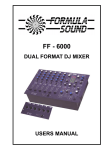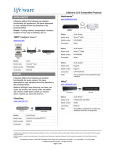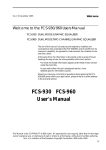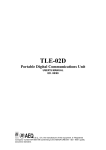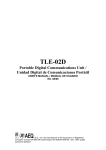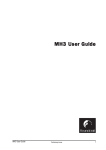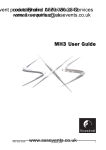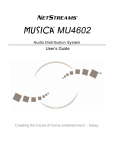Download BSS Audio FDS 310 User`s manual
Transcript
V1.4 29 April 1996 Welcome Welcome to the MSR-602/604 II Users Manual This manual is provided to assist sound engineers, installers and consultants to fully understand the MSR-604 II and to benefit from its full capability. As opposed to most manuals, the contents can be read like a book. At the same time, the information is structured under a series of broad headings for easy access. So where possible within each section: · The most immediate information appears at the head of each section under the main title. · As you read further into each subsequent section, more detailed, specific information is given. Should you have any comments or questions about applying the MSR-604 II within your application, please write to us at the address in the warranty section. MSR-600 II Series User's Manual This Manual is the COPYRIGHT of BSS Audio. All reproduction and copying, other than for the legal owner's personal use, or disclosure of part or whole to a third party, without prior written authorisation, is in violation of the European Copyright Convention. BSS Audio 1996 1 MSR-600 II Series This equipment has been tested and found to comply with the following European Standards for Electromagnetic Compatibility. Emission Specification EN55013 1990 Class B (Associated equipment) Immunity Specification EN50082/1 1992 Mains Disturbance (RF Immunity, Fast Transients and ESD) EN61000/3/2 1995 For continued compliance ensure that all input and output cables are wired with cable screen connected to pin 1 of the XLR. The input XLR pin 1 on BSS equipment is generally connected to chassis via a capacitor to prevent ground loops whilst ensuring good emc compatibility. 2 Table Of Contents Table Of Contents 1.0 1.1 1.2 2.0 2.1 2.2 3.0 Introduction 4 MSR-604 II Mic/Line Signal Splitter MSR-602 II Power Supply Unit 5 6 Unpacking 7 Warranty Warning 7 7 Connections and Control Descriptions 8 3.1 3.2 3.3 3.4 3.5 4.0 AC power connections and control settings DC power connections Audio connections MSR-602 II Controls MSR-604 II Controls System Implementation and Use 4.1 4.2 4.3 4.4 4.5 4.6 4.7 5.0 Racking Grounding Channel coding Dual power supply operation Output drive level setting Multiple output Distribution Amplifier configuration Stereo Summing Configuration 9 11 12 13 14 16 16 18 19 20 20 22 24 Compatibility With Pre Mk II Systems 25 5.1 5.2 5.3 6.0 Installing MSR-604 IIs in a Mk 1 system 25 Installing pre Mk II MSR-604s into a new system 26 Installing a Mk II power supply into a Mk I SYSTEM and vice versa 26 Appendix A 6.1 6.2 7.0 System block diagram and circuit description Transient Suppressor replacement Appendix B 7.1 7.2 Input transformer balancing Output transformer balancing 27 27 28 29 29 29 8.0 Technical Specifications 30 9.0 Warranty 33 3 MSR-600 II Series Introduction 1.0 Introduction It is not uncommon within a sound system which uses microphones as a source of programme, for that microphone to be connected to the input of a number of different processing facilities. An example of this would be in sound reinforcement work where a stage microphone is required to drive the main ‘front of house’ mixing console, the stage monitoring mixing console, a mobile recording studio and quite possibly an outside broadcast recording vehicle. It is also common within such a system for the microphone to be connected to considerable lengths of shielded cable before being terminated at the processing facilitys input connector. Such a load on the microphone is very much in excess of its design capability, and as a consequence the level and quality of the sound is impaired. (Fig. 1) A further complication can arise within such a system from multiple earthing as each of the processing facilities would be providing its own ground. To overcome these problems it is quite common for a multiple winding transformer to be used which provides separate secondary windings for each of the required outputs. This solution will solve the multiple grounding problems, however it does not tackle the sound level and quality problem as, being a passive device, it has no power amplification capability. Cost effective active electronic solutions proved elusive until the introduction of the original BSS MSR-604 overcame the problems of noise and headroom. The current MSR-604 II further improves upon the performance of the original unit with yet greater dynamic range, Fig. 1 Microphone Loading 4 MSR-604 II Microphone Signal Splitter flexibility of gain and level control, internal bus routing, signal metering and a headphone monitoring facility. The MSR-604 II is a four channel, four way signal splitting package and the MSR-602 II is the system power supply capable of supplying power for 40 channels, that is, 10 separate MSR-604 II units. 1.1 MSR-604 Mic/Line Signal Splitter The MSR-604 II has four channels, each of which may be isolated and used totally independently from the next or, by internal re-configuration, be interconnected to form distribution amplifier sections with a single input driving up to 64 outputs. The low noise floor requirement necessitates a remote power supply system, the MSR-602 II, which provides the required DC voltages. A MIC/LINE switch introduces a 20dB input pad, which in combination with the 5 step GAIN switch allows any input signal below + 33dBu to be perfectly matched to the MSR-604 II’s dynamic range. The setting up process is further assisted by the provision of a momentary LISTEN switch which routes the signal to a calibrated HEADROOM meter and a headphone monitor amplifier built into the MSR-602 II power supply unit. Each channel also has a CLIP LED to give constant warning against signal overdrive. As a further refinement a separate 10dB input pad may be activated from the front of house mixing console by switching the desks phantom supply. This remote attenuator allows the engineer to preserve the channel headroom directly from the consolein the event that an input is overdriven. Each channel also provides a separate phantom powering selector switch providing an independent 48V across the ‘mic input’ connector. Each channel has two low impedance electronically balanced outputs on the rear panel to feed the MAIN (Front of House) and the MONITOR mixing consoles. These outputs may be independently configured by internal header blocks to drive at mic (+3dBu clip) or at line (+23dBu clip) levels. A third setting allows these outputs to be driven at +13dBu clip which gives a gain/headroom structure compatible with earlier versions of the MSR-604. The two FEED XLR connectors on the front panel offer microphone level transformer isolated and balanced outputs. 5 MSR-600 II Series MSR-602 II Power Supply 1.2 MSR-602 II Power Supply The MSR-602 II is the system power supply providing all the necessary DC voltages for the MSR-604 II. It utilises a custom designed low field toroidal transformer and separate mumetal screen to reduce the possibility of mains field coupling into the electronic circuitry of the MSR-604 II. The HEADROOM LED meter and high quality headphone amplifier give the operator absolute confidence in signal integrity during setting up, and provide an indispensable aid to trouble shooting and fault detection. The signal wiring involved is contained with the power wiring in a multicore cable for simple interconnection between units. In addition it also carries the main system ground switch which has important considerations within a large system for both safety and noise. PLEASE READ SECTION 4.2 CAREFULLY PRIOR TO OPERATING THE COMPLETE SYSTEM. 6 Unpacking Warranty Warning 2.0 Unpacking As part of our system of quality control, this product is carefully inspected before packing to ensure flawless appearance. After unpacking the units, please inspect for any physical damage and retain the shipping carton and all relevant packing materials, should the unit require repacking. In the event that damage has occurred, immediately notify your dealer, so that a written claim to cover damages can be initiated. 2.1 Warranty The MSR-604 II and MSR-602 II units are warranted by BSS to the original purchaser, against defects in workmanship and materials used in manufacture, for a period of one year from date of shipment. Faults due to purchaser misuse, unauthorised modifications or accidents are not covered by this warranty. No other warranty is expressed or implied. If the unit is faulty, it should be sent, shipping prepaid, to an authorised dealer of the manufacturer stating the faults found. The serial number must be quoted in all correspondence relating to this warranty. 2.2 Warning Because this equipment is connected between the microphone and mixing console or patching system, it is important for safety and system noise that a proper earthing system is implemented within the cabling system. CONSEQUENTLY SECTION 4.2 OF THIS MANUAL MUST BE READ PRIOR TO INSTALLATION AND USE. 7 MSR-600 II Series Connections and Control Descriptions 3.0 Connections and Control Descriptions Fig. 2 MSR-602 II and MSR-604 II 8 AC Power Connections and Control Settings 3.1 AC Power Connections and Control Settings Before connecting the MSR-602 II to the AC power source, check that the voltage selector switch located on the rear panel is correctly set. If a change is necessary, ensure that the mains fuse is also changed for one of the correct rating. Before connecting the DC power leads, check that the system ground switch on the rear panel is also correctly set to ‘earthed’. The power cord attached to this unit carries the following information label. WARNING:THIS APPLIANCE MUST BE EARTHED IMPORTANT: The wires in this mains lead are colour coded in accordance with the following code. Green and yellow : Earth Blue : Neutral Brown : Live As the colours of the wires in the mains lead of this appliance may not correspond with the coloured markings identifying the terminals in your plug, proceed as follows: The wire which is coloured green-and-yellow must be connected to the terminal in the plug which is marked with the letter ‘E’ or by the earth symbol which is ‘ ‘, or coloured green or green-and-yellow. The wire which is coloured blue must be connected to the terminal which is marked with the letter ‘N’ or coloured black. The wire which is coloured brown must be connected to the terminal which marked with the letter ‘L’ or coloured red. Those units that are supplied to the North American market will have an integral moulded 3 pin connector which is provided to satisfy required safety standards. Fig. 3 MSR-602 II Voltage Switch and Mains Fuse 9 MSR-600 II Series Voltage Setting Safety EarthingAC Power Fusing Fig. 4 DC Connection Cabling 3.11 Voltage Setting The mains voltage selector switch provides simple, external adjustment for operation on all international AC power standards. At each switch position there is an acceptable tolerance over which the performance of the unit will not be affected and this is 90v-130v for the 120V position, and 180V-260V for the 240V position. If you subject the unit to voltages in excess of this, you are likely to cause damage. If the mains voltage is below those specified, there will be reduced performance before the unit finally fails to work. 3.12 Safety Earthing The green/yellow wire of mains cord must always be connected to the electrical installations Safety Earth or Ground. It is essential for personal safety, as well as proper operation of the unit, and is internally connected to all exposed metal surfaces. Any rack framework that this unit might be mounted into is assumed to be connected to the same grounding circuit. the MSR-604 II has electronically balanced audio connections and does not need disconnection of any safety earth for the avoidance of hum loops. 3.13 AC Power Fusing The incoming mains power is fused within the MSR-602 II by the fuse holder mounted on the rear panel. If it needs to be replaced it must be properly rated as: 20mm F5A for 240V voltage setting or F6.3A for 120V voltage setting. It is most important for continued safety that this specification is strictly adhered to, and you will have found that spare fuses of this rating are supplied together with your unit and manual. It is very unlikely that this fuse will fail during normal use, and must be treated with some caution as to the cause, if it should do so. One of the most likely reasons will be because the mains voltage switch on the rear panel is incorrectly set. Another reason can be the inadvert- 10 DC Power Connections Fig. 5 Cable Wiring Details ent connection of line to line rather than line to neutral phase voltages when using a three phase supply. In either case internal transient suppressors (VDRs) can become damaged and will consistently blow replacement fuses. You may be assured that they have protected your unit from damage, but they will need removal to allow further use of your unit, and should be replaced as soon as possible to ensure continued protection. If you feel this has happened, please refer to the appropriate section at the rear of this manual for the removal and replacement procedure. 3.2 DC Power Connections DC connection between the MSR-604 II units and the MSR-602 II power supply is by the integral multicore cable with 9 pin D connectors. Note that the MSR-602 II power supply must always be located above the MSR-604 II units. (NB - this is opposite to the way early MSR-604s were racked.) Having the power supply at the top gives superior hum performance, and also places the HEADROOM meter and headphone amplifier in the most convenient position where they will not be obscured by cable looms from the FEED outputs. (Fig 4) The topmost MSR-604 II’s LOOP IN cable is plugged into the power supplies LOOP OUT connector. Each remaining MSR-604 II is connected to the unit above it in similar fashion. Finally the male to female multicore D cable packed with the MSR-602 II is used to loop the final MSR-604 II’s LOOP OUT connector back to the LOOP RETURN socket on the power supply. This ‘ring’ circuit allows a more reliable system set up, since an individual MSR-604 II may be isolated and removed from the rack without disturbing the power to the rest of the system. Ensure that the JACK SCREWS on the connectors are secured and tightened. 11 MSR-600 II Series Audio Connections 3.3 Audio Connections The audio connections to the MSR-604 II are via XLR style connectors on the front and rear panels and their wiring configuration is as shown in figure 5. Attention must be given to maintaining a consistent earthing system for safe and noise free operation. Please refer to section 4.2 for a fuller explanation and design guides. INPUT (REAR PANEL): This is electronically balanced, non floating and is for direct connection to the microphone, DI box or other source of programme. The input is fully RFI suppressed and has excellent common mode rejection performance. Care should be taken to ensure continuity of the pin 1 earth connection. The 48v phantom powering appears across this input when the channel phantom switch is operated. (Refer to section 3.2) MAIN OUT (REAR PANEL): This is electronically balanced, non floating and should be connected to the ‘front of house’ mixing console or main control area. The remote attenuator facility looks at this connector for detection of phantom power voltage. This output should not be connected to an unbalanced input. For consistent remote attenuator switching and microphone screening, it is important that the pin 1 earth connection is maintained. (See section 4.5 for configuring the output drive level.) MON OUT (REAR PANEL): This is electronically balanced, non floating, and should be connected to the stage monitor mixing console or ancillary console which is being operated within the same grounding system. This output should not be connected to an unbalanced input. It is probable that the pin 1 earth connection will need to be disconnected at this point to avoid earth loops. (See section 4.5 for configuring the output drive level.) FEED 1 AND FEED 2 These two identical outputs are actively buffered, fully transformer (FRONT PANEL): balanced and floating with primary/secondary isolation of 2.5kV. They are for connection to any other facility requiring a signal and are totally isolated and independent. There is no connection to the pin 1 earth and all cable screening should be derived from the receiving end. It is also important to ensure there is no earth connection to the shell of the mating female connector as this would make connection to the MSR-602 II chassis ground and cause potential ground loops. 12 MSR-602 II Controls Since all the audio connections are balanced, the convention of pin 2 or pin 3 ‘hot’ is of no consequence provided all connections are wired in a similar manner. Please refer to appendix B for details of the transformer balancing options. 3.4 MSR-602 II Controls SYSTEM GROUND: This switch, located on the rear panel, is the main grounding point for all the MSR-604 II units connected to the system. The switch will connect the electronic/signal ground to chassis earth when in the ‘EARTHED’ position. The switch will disconnect the electronic/signal ground from chassis earth when in the ‘LIFTED’ position. For a more detailed explanation of the grounding arrangements and implications of this switch, please refer to section 4.2. POWER: The LEDs are used to indicate that the power is turned on and present. The LEDs are wired after the main DC Fuses, so should a fuse blow the corresponding LED will go out. The DC fuses are on the rear panel and are clearly marked with value and function. Always replace blown fuses with the correct value. LISTEN: HEADROOM The HEADROOM meter is calibrated to show signal level relative to the METER: clip point. In practice, the red 0db LED will illuminate when the signal is approximately 0.5dB below actual clip. The meter indication is not affected by HEADPHONE LEVEL control. LISTEN: HEADPHONE Adjusts the level of the headphone amplifier from off to full level. LEVEL: Because the amplifier is designed to produce high monitoring levels into any impedance headphones extreme caution must be used when setting headphone levels. CAUTION! ALWAYS TURN LEVEL DOWN BEFORE LISTENING TO UNKNOWN SIGNALS. HIGH EFFICIENCY HEADPHONES AND A HOT SIGNAL CAN PRODUCE DANGEROUS SOUND PRESSURE LEVELS. OBSERVE THE WARNING SYMBOL NEXT TO THE HEADPHONE SOCKET. The gain of the monitor system is such that the amplifier will not clip or distort even if the level control is turned fully up. This ensures that if any distortion or clipping is heard it is not due to the monitoring system and needs to be corrected at the signal source or by adjusting the channel gain settings. 13 MSR-600 II Series MSR-604 II Controls 3.5 MSR-604 II Controls PHANTOM ON/OFF The MSR-602 II power supply provides each MSR-604 II with 48v DC for phantom powering capacitor microphones. This is selected by operating the individual channel switch and it is connected across the ‘input’ connector in the standard phantom powering manner. Typical current availability is 10mA per channel for a 40 channel system. Phantom power is indicated by a front panel LED. It should be noted that phantom powering is interlocked to the LINE/MIC switch so that when LINE input is selected phantom power and the LED indicator are disabled. LINE/MIC This switch introduces a 20dB pad into the input circuit of the unit, and raises the input impedance to suit line level signals. In the mic position the maximum signal level is +13dBu (with the GAIN set to -10dB). In the line position phantom powering is disabled and the maximum permitted signal level is +33dBu (with the GAIN set to -10dB). GAIN The GAIN switch allows the input amplifier gain to be changed in 10dB steps from -10dB to +30dB to precisely match the input signal to the internal headroom of the MSR-604 II. Combined with the very low inherent noise of the input stage this ensures that none of the dynamic range of the source is lost. The absolute system gain is dependent upon the internal system configurations chosen, but with factory default settings and in the MIC position the gain indicated on the GAIN switch setting is correct, i.e. with a mic input, 0dB gain selected and default jumper settings the output level is the same as the input signal. CLIP LED The CLIP LED which is situated below the GAIN switch illuminates when the peak signal level approaches within 1dB of clip. It features a fast acting full wave rectifier and a hold circuit which ensure that all transient peaks are unambiguously indicated. 14 MSR-604 II Controls REMOTE ATTENUATOR A 10dB input pad is activated when the channel detects a +48v phantom signal is present on the MAIN OUTPUT. This allows the front of house mixing engineer to remotely reduce the input signal if he detects that the channel is being overdriven. This is a not uncommon occurrence in live rock and roll, when musicians get into the spirit of a performance and sing louder than during sound checks. A front panel LED indicates when REMOTE ATTENUATOR is active. Because the attenuator slightly degrades the noise and common mode performance of the unit it is recommended that the system is set up and calibrated without the remote attenuator activated, and that it is reserved for emergency use as described above. The remote attenuator function cannot be disabled, so the engineer should observe the same caution with the desk phantom switch as he would if a phantom powered microphone were directly connected to the desk input. CAUTION! USE OF THE DESK PHANTOM SWITCH IS ALMOST CERTAIN TO PRODUCE AN AUDIBLE CLICK SO IT IS RECOMMENDED THAT THE CHANNEL BE CLOSED BRIEFLY DURING SWITCHING. LISTEN Pressing the LISTEN switch connects the channel signal to the HEADROOM meter and headphone amplifier on the MSR-602 II power supply. It is a momentary switch which needs to be held in during monitoring. The listen bus is arranged in such a way that only one channel will register on the monitor section at any time. If two listen switches are pressed at the same time the one that is closest in the chain to the PSU will register. See the MSR-602 II controls section for further details. CAUTION! ALWAYS TURN LEVEL DOWN BEFORE LISTENING TO UNKNOWN SIGNALS. HIGH EFFICIENCY HEADPHONES AND A HOT SIGNAL CAN PRODUCE DANGEROUS SOUND PRESSURE LEVELS. OBSERVE THE WARNING SYMBOL NEXT TO THE HEADPHONE SOCKET. 15 MSR-600 II Series System Implementation and Use Racking 4.0 System Implementation and Use 4.1 Racking It is envisaged that a number of the MSR-604 II units will be racked together with one MSR-602 II power supply. The metal case of the MSR-604 II is not connected to the electronic 0V, and is taken to the mains safety ground via its DC lead connection into Fig. 6 Physical Dimensions 16 Racking the MSR-602 II. The MSR-602 II has a permanent safety ground connection via the power cord. Please read section 4.2 for discussion of grounding of the electronic 0v. The MSR-602 II power supply unit, unlike its predecessor has been designed for mounting at the TOP of a rack, above the MSR-604 II units it powers. In a properly installed MSR system mains induced hum from the PSU will be unmeasurable. If a power supply unit needs to be mounted below a MSR-604 II, the system should be checked for mains induced hum. The following steps may be taken to reduce it. a) Leave a gap of at least 1U between the PSU and the closest MSR-604 II. b) Contact your BSS agent to obtain a mumetal shield which may be affixed to the top cover plate of the MSR-602 II. c) Reduce the number of units in the system. (The stray magnetic field is proportional to the current demanded from the PSU.) In all cases, the MSR-602 II and the MSR-604 II’s MUST be fully supported along their depth. For touring system, failure to observe this precaution will cause eventual metal failure of the MSR-II cases which will not be covered by the guarantee. The physical dimensions and mounting points for the MSR-604 II and MSR-602 II are identical. They are shown in figure 6. In large touring systems, it is envisaged that the rear panel input and output connectors will be wired into a multiway distribution panel forming part of the same rack. In this way, all cabling for the main system is kept tidy and away from the front of the unit. The isolated feeds appearing on the front of the unit are available for the external facilities, and their connection will not interfere with the in-house cabling system. As with any microphone stage box system it is advisable to avoid the close proximity of heavy power cabling, power transformers and all forms of lighting control equipment. 17 MSR-600 II Series Grounding Fig. 7 MSR Grounding 4.2 Grounding In any multi-channel audio system where low level signals are being routed, it is important to ensure a consistent and positive earthing system to minimise any possible noise interference and hum loops. With the use of microphones it is especially important to ensure reliable earthing and screening not only for these noise considerations but also for safety of the performers. Figure 7 shows the internal grounding arrangements for the MSR-602 II and MSR-604 II, and figure 8 shows one of the common earth and grounding arrangements for a complete MSR-600 system, where the microphone shielding is held directly to ground. The star grounding point is the main ‘front of house’ mixing console, and this earth is the one used to shield all cables and the microphone body. There should be no connection between this earth and that of the MSR604 II chassis, and the system ground switch on the MSR-602 II rear panel should be set to ‘lifted’. All the metal casing associated with the MSR-600 II system will be grounded via the MSR-602 II power cord, and through a separate conductor within the DC power lead to the MSR-604 II units. The electronic 0v ground will be connected to the main front of house mixing console earth system via the interconnecting audio cables. Fig. 8 System Grounding Arrangements 18 Channel Coding In general the stage monitor console will be connected to the stage mains power grounding system so the signal connecting cables to the ‘MON OUTPUT’ connector will require the earth connection to be disconnected. That is, the cable screening will be derived from the monitor console, but should not be connected to the electronic 0v earthing system of the MSR-604 II via pin 1 of the connector. This disconnection would be implemented either in the connector, or at the monitor console multiway connector wiring point. Other systems of earthing can be implemented, such as using the stage earth as the main star point, in which case the system ground switch would be set to ‘grounded’, or to use the stage monitor console as the main star point. In any system it is important to remember: a) Choose one star point for all grounding. b) Ensure all microphone screening is permanently held to this ground. c) Ensure that the two main earthing systems, namely stage and front of house, do not accidently short together. d) Avoid sending signal currents along cable screens. If these simple guide lines are followed, then implementation of the MSR-600 system will be completed without any troublesome earthing faults, and full safety will be implicit within the design. 4.3 Channel Coding In a system with more that one MSR-604 II unit, identifying which channel of which MSR is the actual system channel will become necessary, and the small pre-numbered self-adhesive labels supplied with the MSR-604 II can be used for this purpose. Figure 9 shows the fitting of these labels to the MSR-604 II front panel. Fig. 9 Channel Coding 19 MSR-600 II Series Dual Power Supply Operation Output Drive Level Setting 4.4 Dual Power Supply Operation The power supply of the MSR-600 system performs a vital role within the sound system and although designed to exacting standards for ultimate reliability, some systems will require a back-up which would automatically take over on failure of the main supply. This is implemented within the MSR-600 system such that any two MSR602 II units can be directly connected together. Both units are switched on at all times, and power sharing ensures that the system will continue to operate should either unit fail (see figure 10). Fig. 10 Dual Power Supply Connection 4.5 Output Drive Level Setting Each MAIN output and MON output can be individually set to drive at mic or line level. A third setting which may be described as ‘Hot mic level’ is also available in order to provide a headroom structure which is compatible with previous versions of the MSR-604. All outputs are set to mic level when the MSR-604 II leaves the factory. Note that the FEED outputs are set for clip at +3dBm (mic level) only and cannot be changed. The OUTPUT LEVEL SELECT header blocks are clearly marked on the main PCB and are described in Table 1 TABLE 1 OUTPUT LEVEL SELECT JUMPERS Function Jumper No. PCB identification Channel 1 MAIN OUT JP2 CH1 MAIN O/P Channel 1 MON OUT JP1 CH1 MON O/P Channel 2 MAIN OUT JP6 CH2 MAIN O/P Channel 2 MON OUT JP5 CH2 MON O/P Channel 3 MAIN OUT JP10 CH3 MAIN O/P Channel 3 MON OUT JP9 CH3 MON O/P Channel 4 MAIN OUT JP14 CH4 MAIN O/P Channel 4 MON OUT JP13 CH4 MON O/P 20 Fig. 11 Output Level Select Jumpers The permissible settings are shown in Figure 11, and the effects of each on system gain and headroom is described in Table 2. Note that combinations of header settings other than those shown should not be used as they do not give a proper balanced drive. TABLE 2 OUTPUT LEVEL SELECT HEADROOM AND GAIN STRUCTURE Setting 3dBm 13dBm 23dBu Output clip System gain Description Level /dB (Note 1) +3dBm 0 Mic level output. Factory default +13dBm +10 MSR-604 pre Mk II compatibility +23dBu +20 Line level output (Note 1. Gain between input XLR and output XLR with channel Gain switch set to 0dB and input pad set to MIC). NOTE: The output levels are referred to using both dBm and dBu for different settings. This is because the unit is capable of driving 3dBm or 13dBm into a 600Ω load but the 23dBu output, although capable of driving 600Ω will, drop slightly in level for loads below 2kΩ. 21 MSR-600 II Series Multiple Output Distribution Amplifier Configuration Fig. 12 Bus Linking Block Diagram. Default Jumpers 4.6 Multiple Output Distribution Amplifier Configuration For use as a distribution amplifier, or in any situation where more than four outputs per channel are required, the MSR-604 II system may be reconfigured by moving internal jumpers. Up to sixteen adjacent channel sections, a total of sixty four outputs may be driven from a single input stage. JUMPER SETTING The simplified block diagram, Figure 12 shows the segmented internal bus which runs between adjacent channels. This bus is continued via the multiway LOOP connector between MSR-604 II units, allowing blocks of D.A. channel to span several output sections. Figure 12 shows the bus and the bus linking headers in their default settings, i.e. each channel input section is connected to its own output section. The default jumper positions are identified on the PCB by a white block printed adjacent to the relevant jumper pins. By way of example, Figure 13A illustrates a typical distribution amplifier arrangement where Channel 1 input section is used to drive its own and Channel 2’s output sections and, likewise, Channel 3 input is driving the outputs of both Channel 3 and Channel 4. 22 Multiple Output Distribution Amplifier Configuration Fig. 13A Bus Linking Ch1 Drives Out1 and 2 Ch3 Drives Out3 and 4 The signal labelled EXBUS-OUT passes via the LOOP OUT connector to the EXBUS-IN terminal in the LOOP IN connector on the adjacent unit, allowing a D.A. channel to span more than one MSR-604 II unit. It will be apparent from the above example that the permutations of D.A. blocks that can be configured within a system is limited only by the number of MSR-604 IIs that are connected in the rack. The limiting factor on how many channels may be linked is the parallel loading that occurs on the drive from the input stage. The recommended maximum is sixteen, which equates to sixty four outputs. This will result in an overall drop in system gain of about 0.7dB but should not significantly affect noise or distortion. It is strongly advised that in order to have a configuration work first time, that the required system is first planned out on paper, and with reference to Figures 12, 13A and 13B, a list of jumper settings is produced. Implementing the system then becomes a simple mechanical task of setting the relevant jumpers. 23 MSR-600 II Series Multiple Output Distribution Amplifier Configuration Stereo Summing Configuration Fig. 13B Bus Linking In1+In2 Drives Out1 and 2 In3+In4 Drives Out3 and 4 CONTROLS When a group of channels is linked as a D.A., the controls associated with the chosen input section are used to set the required operating conditions. the controls on the other channels are disabled, except for the CLIP LEDs and the LISTEN switches which may be used to confirm that the signal is reaching all the linked output stages. 4.7 Stereo Summing Configuration 24 Figure 13B above shows an alternate bus configuration where a stereo pair of inputs is used to drive two output channels in parallel. Each output is a sum of the pair of inputs reduced by 6dB. Compatibility With Pre MkII Systems Installing MSR-604 IIs in a Mk 1 System 5.0 Compatibility With Pre MkII Systems Limited compatibility exists between early MSR-604 systems and MSR604 II units using adaptor leads to interconnect the power cables. Please order adaptor leads as MSR-604 Mk I adaptor kit Z-MSRIIADK01. This pair of cables is required for any of the system combinations described below. Only one adaptor set is required per system no matter how many new units are to be to be installed. 5.1 Installing MSR-604 IIs in a Mk I System The MSR-604 II may be used to extend an existing rack which uses earlier versions of MSR-600 components. Although the Mk II units will perform better than the originals, some of the enhanced performance and features will be lost. In general the dynamic range will be reduced by about 2dB and the LISTEN monitoring function will not be available. Also channel bus linking will be restricted to operating within individual MSR-604 II units. SETTING SYSTEM Remove the top cover plates on MSR-604 IIs and locate the two JUMPERS jumpers JP14 and JP15 next to the aluminium regulator heatsink. These jumpers will be shipped set to the factory default position, indicated by a solid bar printed on the PCB. Move the jumper blocks away from the default to cover the left and centre pins. It will be noted that yellow LEDs LD9 and LD10 do not now illuminate when power is applied. Replace the cover plate before installing in the rack. RACK INSTALLATION The new units should be mounted at the top of the rack, away from the MSR-602 power supply. If more than one MSR-604 II is being installed, the LOOP IN/LOOP OUT connectors are ‘daisy’ chained’ 25 MSR-600 II Series Installing Pre Mk II MSR-604s Into a New System Installing a Mk II Power Supply Into a Mk I System and Vice Versa 5.2 Installing Pre Mk II MSR-604s Into a New System RACK INSTALLATION 5.3 Installing a Mk II Power Supply Into a Mk I System and Vice Versa 26 together as described in section 3.2. Finally the pair of adaptor leads are used to insert the Mk II units into the systems power circuit. Early MSR-604 units may be added to a Mk II system, but will gain no improvement in performance from the new system. They will run slightly warmer since they will be running from a higher DC voltage supply but there is no danger of damage or impaired reliability. No changes are required to any internal jumpers or settings and provided that the Mk I units are installed at the ‘end’ of the DC daisychain, the performance of the Mk II units will not be affected in any way. The Mk I MSR-604s should be mounted at the bottom of the rack, away from the power supply. Using the adaptor leads connect the Mk I units between the MSR-602 II LOOP RETURN socket and the final MSR-604 II LOOP OUT socket. If the units are wired into the DC loop wiring at a different point, the LISTEN BUS and the EXBUS-IN/OUT linking between Mk II MSR units will be broken, disabling these functions. Mixing Mk I and Mk II power supplies and systems is not generally recommended. Since they are designed to work at different DC rail voltages, performance and facility will be reduced to the lowest common denominator at best. Contact your BSS agent for availability and Appendix A System Block Diagram and Circuit Description 6.0 Appendix A 6.1 System Block Diagram and Circuit Description advice if a replacement or a second power supply is required for a Mk I system. Figure 14 shows the block diagram of the audio section of the MSR604 II. The DC supply regulator circuits (not shown) are common to all channels. The rails to each channel are protected by fusible resistors so that in the event of a short circuit fault in one channel the other three are not affected. The input signal passes via RFI filters to the MIC/LINE switch, a balanced 20dB pad, and then to the REMOTE ATTENUATOR. This is a Fig. 14 MSR-604 II Block Diagram 27 MSR-600 II Series Transient Suppressor Replacement balanced 10dB pad using a relay controlled by a circuit which monitors the MAIN OUTPUT XLR for the presence of phantom DC voltage. The balanced signal then passes through the optional input transformer, if fitted, and DC blocking capacitors to the low noise INPUT AMPLIFIER. This stage provides the common mode rejection trim, GAIN switch and provides a line level low impedance unbalanced drive signal to the BUS LINKING HEADERS. In the default mode the channel signal is not routed to the bus but is passed to the channel output stages. The OUTPUT AMPLIFIER has two out of phase line driving outputs which are DC blocked and passed to both the balanced MAIN OUTPUT ATTENUATOR and the balanced MONITOR OUTPUT ATTENUATOR. The signals are then fed to the MAIN OUT and the MON OUT XLRs respectively. The low impedance attenuators ensure that a faulty cable or load on one output will not affect the other and also allow the output drive levels to be independently set to +23dBu, +13dBm, or +3dBm at clip. If the optional output transformers are installed, they are fitted in place of the attenuators and the output headroom is preset at +3dBu. The FEED AMPLIFIER buffers the signal and drives the dual secondary isolating FEED TRANSFORMER which is connected to the two FEED output XLRs mounted on the front panel. 6.2 Transient Suppressor Replacement The LISTEN AMPLIFIER buffers the signal before presenting it to the LISTEN switch. This in turn is connected to the listen bus for monitoring on the HEADROOM METER and HEADPHONE AMPLIFIER which are located in the MSR-602 II power supply. The primary of the mains transformer within the MSR-602 II is protected against high voltage spike interference by two voltage dependent resistors. These provide a short circuit to voltage peaks in excess of their maximum rating. Should the MSR-602 II be inadvertently connected to 3 phase line/line voltages, or to 240V when selected to 120V, or any other incorrect voltage, these suppressors are likely to fail in a protective short circuit mode. This will be demonstrated by repeated mains fuse failure when powering up the unit. Even in this case of extreme overvoltage, the MSR-602 II is protected against failure, and the simple removal of these suppressors will allow the unit to be used again. However, it is important that they are replaced as soon as possible to ensure continued protection. Fig. 15 Transient Suppressor Details 28 Appendix B Input Transformer Balancing Output Transformer Balancing 7.0 Appendix B 7.1 Input Transformer Balancing Figure 15 indicates the location and specification for the suppressors. In some situations it might be necessary to provide a transformer balanced input and provision has been made within the MSR-604 II for it’s mounting. Please order as ‘MSR-604 II input transformer kit Z-MSRTXIII-01’. This is per channel, with four required for one MSR-604 II unit. Full fitting instructions are provided with this kit. 7.2 Output Transformer Balancing Provision has been made within the MSR-604 II to fit 600 ohm transformers to the ‘main’ and ‘mon’ outputs to provide floating and isolated outputs. 29 MSR-600 II Series Technical Specifications 8.0 Technical Specifications MSR-604 II Please order as ‘MSR-604 II balanced output transformer kit ZMSRTX0II-01’. This is per channel with four required for one MSR-604 II unit. Full fitting instructions are provided with this kit. Channels Four: Independant or internally interconnected Inputs XLR-3F Electronically balanced (Transformers optional) Microphone Line Impedance 2kΩ 10kΩ Max. input level +13dBu +33dBu CMRR >90dB @ 1kHz >75dB 50Hz to 10kHz Phantom Power 48VDC via panel switch and LED indicator Outputs Main (FOH) & Mon, XLR-3M, Electronically balanced (Transformers optional) Max level (internally preset) +3dBm +13dBm +23dBu Impedance <23Ω <71Ω <100Ω Max load 200Ω 600Ω 600Ω Feeds: Two, XLR-3M, Transformer balanced Max level +3dBu Impedance <50Ω Max load 600Ω Isolation 2.5kV ACrms for 1 minute Gain -40dB to +50dB in 10dB steps Gain switch -10, 0, 10, 20, 30dB via panel Mic/Line pad 0/-20dB via panel Remote pad 0/-10dB via F.O.H. phantom Output scaling +20/+10/0dB via internal jumper blocks (Main & Mon only) Frequency Response <+/-0.5dB 20Hz to 20kHz Noise (E.I.N.) (20Hz to 20kHz) -10dB gain <-114dBu 0dB gain <-121dBu 10dB gain <-124dBu 20dB gain <-125dBu 30dB gain <-126dBu Distortion (T.H.D.) <0.01% 20Hz to 20kHz @ 10dB below clip Level Metering & Monitoring Channel Clip LED @ 1dB below clip Headroom meter on MSR-602 II PSU Six point LED meter: 0,-1,-3,-6,-12,-26dB Via Listen switch (momentary) Headphone monitor on MSR-602 II PSU Via Listen switch (momentary) 30 Technical Specifications Stereo/Mono Load Impedance Max output Level control MSR-602 II 1/4in Jack socket 4Ω to 600Ω 1W rms -90dB to 0dB Power +/-27VDC, +48VDC from MSR-602 II PSU only Connectors 9 pin ‘D’, with lock jackscrews Weight 3.8kg Net Size 1.75" x 19" x 11.6" (44 x 482 x 293 mm) excluding connectors AC Input 90-130/180-260VAC 50/60Hz @ 150VAC Connector 3 pin IEC with locking clip Voltage selector Rear panel 120/240V Switch Rear panel High-inrush Fuse Rear panel F6.3A(120V) / F5A(240V) DC Outputs +27V unregulated @ 4A max: low ripple -27V unregulated @ 4A max: low ripple +48V +/-5% regulated @ 500mA max Rear panel Fuses F5A(+27V) F5A(-27V) F500mA(+48V) Connectors 9 pin ‘D’ female Loop out 9 pin ‘D’ male Loop return System Ground Lift Indicators Rear panel Slide switch 3 LEDs, post fuse, on +27V, -27V and +48V outputs Headroom Meter Via Listen bus and MSR-604 II Listen switch (momentary) Six point LED meter 0, -1, -3, -6, -12, -26dB ref clip Input via DC Loop out connector Headphone Monitor Via Listen bus and MSR-604 II Listen switch (momentary) Input: via DC Loop out connector Connector Stereo/Mono 1/4 Jack socket Load impedance 4Ω to 600Ω Max output 4Ω:860mWrms 200Ω:750mW rms Level control Continuously variable -90dB to 0dB Headroom >MSR-604 II channel clip In keeping with our policy of continued improvement, BSS Audio reserve the right to alter specifications without prior notice. 31 MSR-600 II Series Technical Specifications Weight 7.0 kg Net Size 1.75" x 19" x 11.6" (44 x 482 x 293mm) excluding connectors Should you experience any difficulty in operating this equipment please contact your local dealer who will also be able to supply you with information on the full range of equipment manufactured by BSS Audio. DPR-402 2 Channel Compressor, De-esser, and Peak Limiter DPR-404 4 Channel Compressor and De-Esser DPR-502 2 Channel Noise Gate with Midi Interface DPR-504 4 Channel Noise Gate DPR-901 Dynamic Equaliser EPC-760 High Power Audio Amplifier EPC-780 High Power Audio Amplifier FCS-926 Varicurve Dual Equaliser/Analyser FCS-920 Varicurve Dual Equaliser/Analyser FPC-900 Varicurve Remote Control System FCS-960 2 Channel 30 Band Graphic Equaliser FDS-310 2/3/4 Way Variable Electronic Crossover FDS-318 Stereo Multimode Electronic Crossover FDS-360 Programmable Electronic Crossover with Limiters and Phase Correction. MSR-604 II 4 Channel Active Microphone Signal Distribution and Splitting System. 32 AR-116 Active Direct Injection (DI) Box. AR-117 Phantom Powering Accessory for AR-116. AR-130 System Polarity Checker. AR-125 Lead and Fuse Checker. AR-204 Transformer Line Balancing Unit. AR-416 4-Channel Active D.I. Warranty 9.0 Warranty Information This unit is warranted by BSS Audio to the original end user purchaser against defects in workmanship and the materials used in its manufacture for a period of one year from the date of shipment to the end user. Faults arising from misuse, unauthorised modifications or accidents are not covered under this warranty. No other warranty is expressed or implied. If the unit is faulty it should be sent, in its original packaging, to the supplier or your local authorised BSS Audio dealer with shipping prepaid. You should include a statement listing the faults found. The unit’s serial number must be quoted in all correspondence relating to a claim. We recommend that you record your purchase information here for future reference. IMPORTANT Dealer Name: Dealer Address: Post/Zip Code: Dealer Phone No.: Dealer Contact Name: Invoice/Receipt No.: Date of Purchase: Unit Serial Number: In keeping with our policy of continued improvement, BSS Audio reserves the right to alter specifications without prior notice. This product was designed, developed and produced by BSS Audio, Hertfordshire, England. Phone (+44) (0)1707 660667. Fax (+44) (0)1707 660755. 33 MSR-600 II Series USER NOTES 34 USER NOTES 35 MSR-600 II Series USER NOTES 36





































